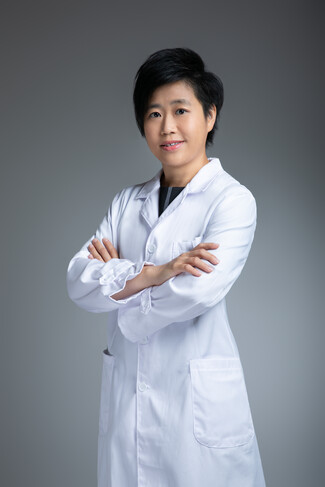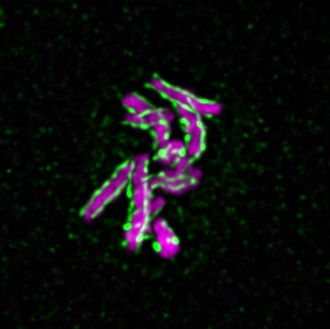 | Dr Karen Wing Yee YUEN Associate Professor of School of Biological Sciences
|
Q: What do you think are your most significant research accomplishments, and what has been the impact of your research?
A: My most significant research accomplishments are contributing to the understanding of how centromere functions. The centromere is the unique region on each chromosome that binds to microtubules emanated from the opposite spindle poles to orchestrate chromosome movement and segregation in every cell division. My lab has provided insights into the epigenetic regulation of centromere function and elucidated the centromere formation process in vivo. For the epigenetic regulation aspect, the centromere has been traditionally viewed as a compact, inert region on the chromosome that is devoid of genes and transcription activity. However, in the last decade, it has been shown that transcription through the centromere in many species is indeed important for its function. Our lab is the first to show that even short, point centromere from simple, single-celled eukaryotic organism Saccharomyces cerevisiae, that is the baking or brewing yeast, requires transcription to maintain centromere function. Using another multicellular model organism, the transparent nematode C. elegans, our lab discovered that foreign, naked DNA injected into the gonad of nematode can lead to fusion of injected DNA to form a chromatin-packaged artificial chromosome (AC), that is capable of replicating and accurately segregating within a few cell cycles. (We identified the histone chaperone, histone modifiers and chromatin-binding proteins required for centromere formation, and we analyzed if DNA sequences play a role in determining the centromere position.)
The impact of my research is not limited to these observations in these model organisms. By comparing what we learn from different organisms well separated in evolution prompts researchers to further investigate how the first eukaryotic chromosome was constructed (as they differ significantly with prokaryotic chromosome), and how each organism evolves its chromosomes to adapt to its needs. Our results also have implications to cancer research, as chromosome instability (CIN) is one of the underlying hallmarks of many solid cancers, but the molecular causes and consequences of it is still unclear. Centromere inactivation or new centromere formation could initiate CIN.
Q: Please give a brief description of 1 - 2 ongoing research projects that best reflect your visions in the scientific field.
A: Two on-going projects that best reflect my visions in the scientific field are follow up studies of the above findings. In the centromere RNA transcription project, we are currently trying to visualise the centromeric RNA directly by live-cell imaging, in order to understand its spatial, temporal dynamics within the cell cycle, and to get some clues on its function. Moreover, we would like to discover whether the RNA transcription process or the product, centromeric RNA, or both, are important to centromere function and how.
For the second project on de novo centromere formation, we are trying to again visualize the epigenetic changes during the centromere formation process in real-time, so as to understand what proteins, such as histone chaperones, and what histone modifications are required. At the same time, we are investigating what DNA sequences or properties are favorable for centromeric protein maintenance.
Q: What is the most important question you want to address?
A: The most important question I want to address is how centromere maintains its stability through mitotic cell cycles and through multiple generations. This can be achieved by studying how different genetic and epigenetic pathways contribute to maintain centromere identity. On the flip side, by understanding how centromeres are inactivated or how new centromeres are formed in pathological conditions, we can get a peek at how normal cells cope with the situation faithfully day after day.
Q: Can you give an example of your translational work?
A: One example of my translational work was my PhD work, where I used yeast as a model to perform a genome-wide screening of CIN mutants by a visual, color assay. We discovered ~300 mutants that exhibit CIN phenotypes in yeast. Based on these candidate genes and their conserved homologs in humans, we asked whether these set of genes are highly mutated in human solid cancers, so we sampled colorectal cancer patient samples and identified that a few genes involved in sister chromatid cohesion (a cellular process required to hold the replicated sister chromosomes together after DNA replication and before they separate) are highly mutated, and can contribute to CIN in human cells.
If we understand the mechanism of centromere formation, then we can engineer more stably propagating artificial chromosomes to carry any gene of interest, for studying specific gene function, or for gene therapy. Developing a stable vehicle for a wild type, functional gene that distributes equally to daughter cells and constantly expresses the gene in the defective cells has been one of the hurdles in gene therapy application. Though CRISPR-Cas9 has also been proposed to be a potential solution for integrating the correct gene, integration into the genome has the possibility of causing off-target insertions and mutagenesis. On the other hand, ACs aim to host the gene of interest, and maintain it independently from the endogenous chromosomes, thus avoiding such problems.
Q: Where do you see yourself in five years/ten years? What do you want to accomplish the most?
A: I see myself continue to contribute and lead in the field of centromere regulation and chromosome stability. I believe that basic, fundamental research in understanding how nature works should precede, or be done in parallel with translational research or biomedical engineering. Researchers can first humbly learn how existing organisms tackle the problem before engineering and improving our designs, as nature may already have the best solutions awaiting for us to discover. Our lab projects will still focus on the conserved, important cellular mechanisms, but will also expand to have synthetic biology and translational components.
Q: How would you bridge the gap from your research to research users?
A: I would try to bridge the gap from my research to research users by first bringing the awareness and interest of our current research to people in society through science outreach events such as talks in science museums, press conferences, releases and videos, and Junior Science Institute (JSI) where secondary schools come to visit our labs and do hands-on experiments, and in-person visits to elementary and secondary schools. Recently, I have tried to draw and make a children story book about two brothers fighting each other, their adventure, their inheritance, commonalities and differences, and the development of life from a single cell to an embryo through cell division. It is based on some real experience from my two boys. The completely new endeavor has prompted me to further think how to share the wonders in life, nature and fun in science with kids.
Q: What are the challenges you are facing?
A: The challenges I am facing are to juggle and manage time among projects, to apply for the rather short-term funding schemes every year and to recruit enthusiastic, qualified post-doctoral fellows.
As we want to explore and develop both basic mechanistic investigations, synthetic biology designs and translational applications, we have to continue what we are good at, but also try to take risks, and learn to collaborate with experts in different disciplines. We also need to recruit young scholars with different expertise.
Q: Who has influenced you the most?
A: My Physics teacher in my secondary school would make us do the experiments ourselves instead of just believing in what he said. This had seeded my curiosity in science and encouraged me to design experiments to test out different things. My interest in Genetics and Cell Biology grew while I did my Final Year Project with Dr Lynne QUARMBY at Simon Fraser University, where I worked with another single-celled green algae to study its flagella function and how it swims.
Q: How would you go about motivating yourself when you are going through a low point?
A: Sometimes when I am going through a low point, I would list out and analyse the worst situations, and comfort myself that they are indeed not as bad as I originally thought. This way, I can motivate myself to take risks and give my best try to overcome the problem.

Immunofluorescence image of condensed chromosomes (magenta) and holocentromere (green) in mitosis in an embryonic cell of the model organism Caenorhabditis elegans.

